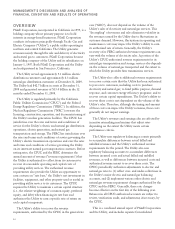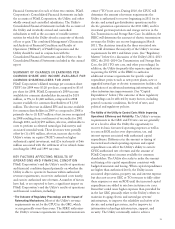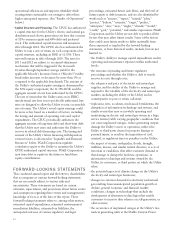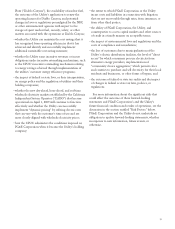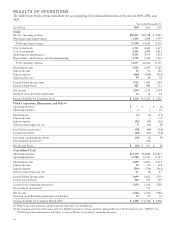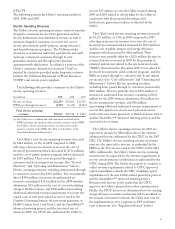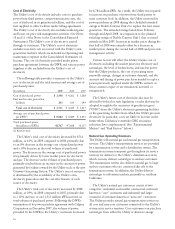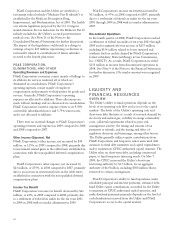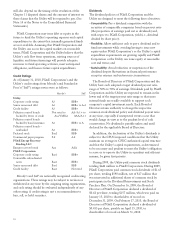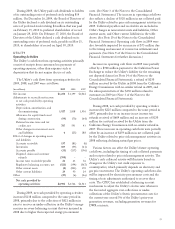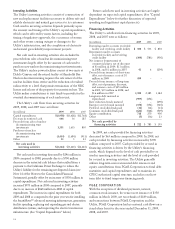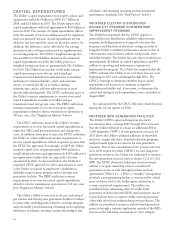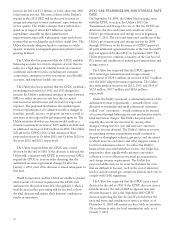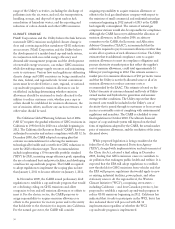PG&E 2009 Annual Report Download - page 24
Download and view the complete annual report
Please find page 24 of the 2009 PG&E annual report below. You can navigate through the pages in the report by either clicking on the pages listed below, or by using the keyword search tool below to find specific information within the annual report.PG&E Corporation and the Utility are entitled to a
tax-exempt federal subsidy (“Medicare Part D subsidy”) as
established by the Medicare Prescription Drug,
Improvement, and Modernization Act of 2003. The health
care reform legislation proposed by the U.S. Congress
would eliminate the tax deduction for the Medicare Part D
subsidy included in the Utility’s accrued postretirement
medical costs. (See Note 13 of the Notes to the
Consolidated Financial Statements for further discussion).
The impact of this legislation could result in a charge to
earnings of up to $25 million representing a reduction in
tax benefits related to contributions of future subsidies
received to the benefit plan trusts.
PG&E CORPORATION,
ELIMINATIONS, AND OTHER
Operating Revenues and Expenses
PG&E Corporation’s revenues consist mainly of billings to
its affiliates for services rendered, all of which are
eliminated in consolidation. PG&E Corporation’s
operating expenses consist mainly of employee
compensation and payments to third parties for goods and
services. Generally, PG&E Corporation’s operating
expenses are allocated to affiliates. These allocations are
made without mark-up and are eliminated in consolidation.
PG&E Corporation’s interest expense relates to its 9.50%
convertible subordinated notes and 5.75% senior notes,
and is not allocated to affiliates.
There were no material changes to PG&E Corporation’s
operating revenues and expenses in 2009 compared to 2008
and 2008 compared to 2007.
Other Income (Expense), Net
PG&E Corporation’s other income, net increased by $40
million, or 125%, in 2009 compared to 2008, primarily due
to investment-related gains in the rabbi trusts established in
connection with the non-qualified deferred compensation
plans.
PG&E Corporation’s other expense, net increased by
$23 million, or 255%, in 2008 compared to 2007, primarily
due to an increase in investment losses in the rabbi trusts
established in connection with the non-qualified deferred
compensation plans.
Income Tax Benefit
PG&E Corporation’s income tax benefit decreased by $41
million, or 65%, in 2009 compared to 2008, primarily due
to a settlement of federal tax audits for the tax years 2001
to 2004 in 2008 with no similar adjustment in 2009.
PG&E Corporation’s income tax benefit increased by
$31 million, or 97%, in 2008 compared to 2007, primarily
due to a settlement of federal tax audits for the tax years
2001 through 2004 in 2008 with no similar adjustment in
2007.
Discontinued Operations
In the fourth quarter of 2008, PG&E Corporation reached
a settlement of federal tax audits of tax years 2001 through
2004 and recognized after-tax income of $257 million,
including $154 million related to losses incurred and
synthetic fuel tax credits claimed by PG&E Corporation’s
former subsidiary, National Energy & Gas Transmission,
Inc. (“NEGT”). As a result, PG&E Corporation recorded
$154 million in income from discontinued operations in
2008. (See Note 9 of the Notes to the Financial Statements
for further discussion.) No similar amount was recognized
in 2009.
LIQUIDITY AND
FINANCIAL RESOURCES
OVERVIEW
The Utility’s ability to fund operations depends on the
levels of its operating cash flow and access to the capital
markets. The levels of the Utility’s operating cash and
short-term debt fluctuate as a result of seasonal demand for
electricity and natural gas, volatility in energy commodity
costs, collateral requirements related to price risk
management activity, the timing and amount of tax
payments or refunds, and the timing and effect of
regulatory decisions and financings, among other factors.
The Utility generally utilizes equity contributions from
PG&E Corporation and long-term senior unsecured debt
issuances to fund debt maturities and capital expenditures
and to maintain its CPUC-authorized capital structure. The
Utility relies on short-term debt, including commercial
paper, to fund temporary financing needs. On May 7,
2009, the CPUC increased the Utility’s short-term
borrowing authority by $1.5 billion, for an aggregate
authority of $4.0 billion, including $500 million that is
restricted to certain contingencies.
PG&E Corporation’s ability to fund operations, make
scheduled principal and interest payments, refinance debt,
fund Utility equity contributions as needed for the Utility
to maintain its CPUC-authorized capital structure, and
make dividend payments primarily depends on the level of
cash distributions received from the Utility and PG&E
Corporation’s access to the capital markets.
20


